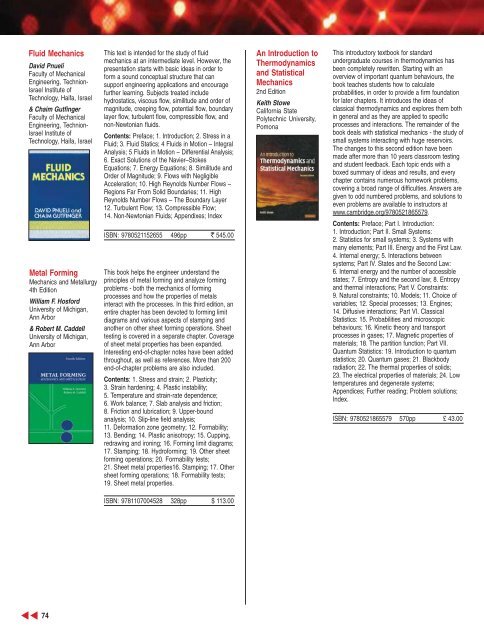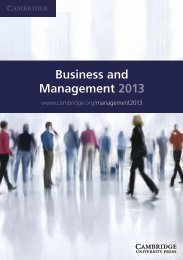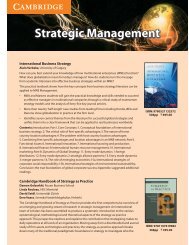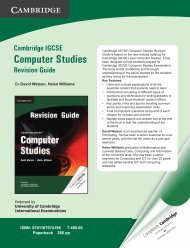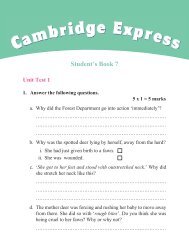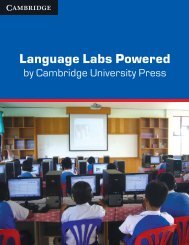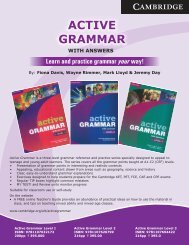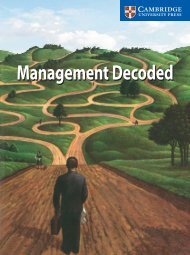ENGINEERING - Cambridge University Press India
ENGINEERING - Cambridge University Press India
ENGINEERING - Cambridge University Press India
You also want an ePaper? Increase the reach of your titles
YUMPU automatically turns print PDFs into web optimized ePapers that Google loves.
Fluid Mechanics<br />
David Pnueli<br />
Faculty of Mechanical<br />
Engineering, Technion-<br />
Israel Institute of<br />
Technology, Haifa, Israel<br />
& Chaim Gutfinger<br />
Faculty of Mechanical<br />
Engineering, Technion-<br />
Israel Institute of<br />
Technology, Haifa, Israel<br />
Metal Forming<br />
Mechanics and Metallurgy<br />
4th Edition<br />
William F. Hosford<br />
<strong>University</strong> of Michigan,<br />
Ann Arbor<br />
& Robert M. Caddell<br />
<strong>University</strong> of Michigan,<br />
Ann Arbor<br />
This text is intended for the study of fluid<br />
mechanics at an intermediate level. However, the<br />
presentation starts with basic ideas in order to<br />
form a sound conceptual structure that can<br />
support engineering applications and encourage<br />
further learning. Subjects treated include<br />
hydrostatics, viscous flow, similitude and order of<br />
magnitude, creeping flow, potential flow, boundary<br />
layer flow, turbulent flow, compressible flow, and<br />
non-Newtonian fluids.<br />
Contents: Preface; 1. Introduction; 2. Stress in a<br />
Fluid; 3. Fluid Statics; 4 Fluids in Motion – Integral<br />
Analysis; 5 Fluids in Motion – Differential Analysis;<br />
6. Exact Solutions of the Navier–Stokes<br />
Equations; 7. Energy Equations; 8. Similitude and<br />
Order of Magnitude; 9. Flows with Negligible<br />
Acceleration; 10. High Reynolds Number Flows –<br />
Regions Far From Solid Boundaries; 11. High<br />
Reynolds Number Flows – The Boundary Layer<br />
12. Turbulent Flow; 13. Compressible Flow;<br />
14. Non-Newtonian Fluids; Appendixes; Index<br />
ISBN: 9780521152655 496pp ` 545.00<br />
This book helps the engineer understand the<br />
principles of metal forming and analyze forming<br />
problems - both the mechanics of forming<br />
processes and how the properties of metals<br />
interact with the processes. In this third edition, an<br />
entire chapter has been devoted to forming limit<br />
diagrams and various aspects of stamping and<br />
another on other sheet forming operations. Sheet<br />
testing is covered in a separate chapter. Coverage<br />
of sheet metal properties has been expanded.<br />
Interesting end-of-chapter notes have been added<br />
throughout, as well as references. More than 200<br />
end-of-chapter problems are also included.<br />
Contents: 1. Stress and strain; 2. Plasticity;<br />
3. Strain hardening; 4. Plastic instability;<br />
5. Temperature and strain-rate dependence;<br />
6. Work balance; 7. Slab analysis and friction;<br />
8. Friction and lubrication; 9. Upper-bound<br />
analysis; 10. Slip-line field analysis;<br />
11. Deformation zone geometry; 12. Formability;<br />
13. Bending; 14. Plastic anisotropy; 15. Cupping,<br />
redrawing and ironing; 16. Forming limit diagrams;<br />
17. Stamping; 18. Hydroforming; 19. Other sheet<br />
forming operations; 20. Formability tests;<br />
21. Sheet metal properties16. Stamping; 17. Other<br />
sheet forming operations; 18. Formability tests;<br />
19. Sheet metal properties.<br />
An Introduction to<br />
Thermodynamics<br />
and Statistical<br />
Mechanics<br />
2nd Edition<br />
Keith Stowe<br />
California State<br />
Polytechnic <strong>University</strong>,<br />
Pomona<br />
This introductory textbook for standard<br />
undergraduate courses in thermodynamics has<br />
been completely rewritten. Starting with an<br />
overview of important quantum behaviours, the<br />
book teaches students how to calculate<br />
probabilities, in order to provide a firm foundation<br />
for later chapters. It introduces the ideas of<br />
classical thermodynamics and explores them both<br />
in general and as they are applied to specific<br />
processes and interactions. The remainder of the<br />
book deals with statistical mechanics - the study of<br />
small systems interacting with huge reservoirs.<br />
The changes to this second edition have been<br />
made after more than 10 years classroom testing<br />
and student feedback. Each topic ends with a<br />
boxed summary of ideas and results, and every<br />
chapter contains numerous homework problems,<br />
covering a broad range of difficulties. Answers are<br />
given to odd numbered problems, and solutions to<br />
even problems are available to instructors at<br />
www.cambridge.org/9780521865579.<br />
Contents: Preface; Part I. Introduction:<br />
1. Introduction; Part II. Small Systems:<br />
2. Statistics for small systems; 3. Systems with<br />
many elements; Part III. Energy and the First Law.<br />
4. Internal energy; 5. Interactions between<br />
systems; Part IV. States and the Second Law:<br />
6. Internal energy and the number of accessible<br />
states; 7. Entropy and the second law; 8. Entropy<br />
and thermal interactions; Part V. Constraints:<br />
9. Natural constraints; 10. Models; 11. Choice of<br />
variables; 12. Special processes; 13. Engines;<br />
14. Diffusive interactions; Part VI. Classical<br />
Statistics: 15. Probabilities and microscopic<br />
behaviours; 16. Kinetic theory and transport<br />
processes in gases; 17. Magnetic properties of<br />
materials; 18. The partition function; Part VII.<br />
Quantum Statistics: 19. Introduction to quantum<br />
statistics; 20. Quantum gases; 21. Blackbody<br />
radiation; 22. The thermal properties of solids;<br />
23. The electrical properties of materials; 24. Low<br />
temperatures and degenerate systems;<br />
Appendices; Further reading; Problem solutions;<br />
Index.<br />
ISBN: 9780521865579 570pp £ 43.00<br />
ISBN: 9781107004528 328pp $ 113.00<br />
74


